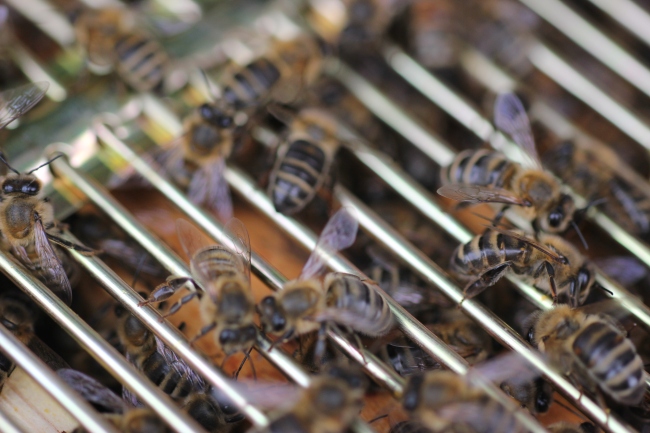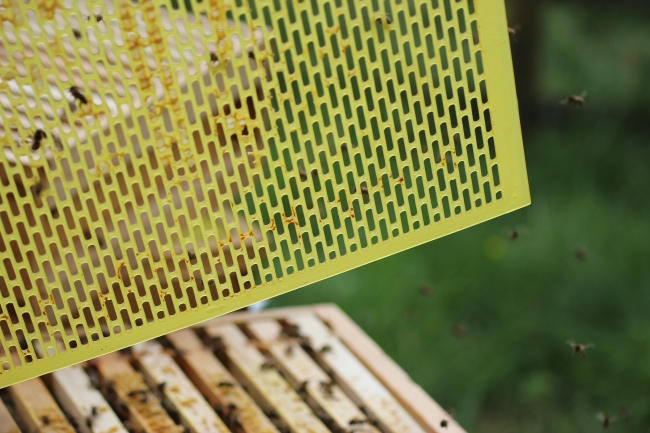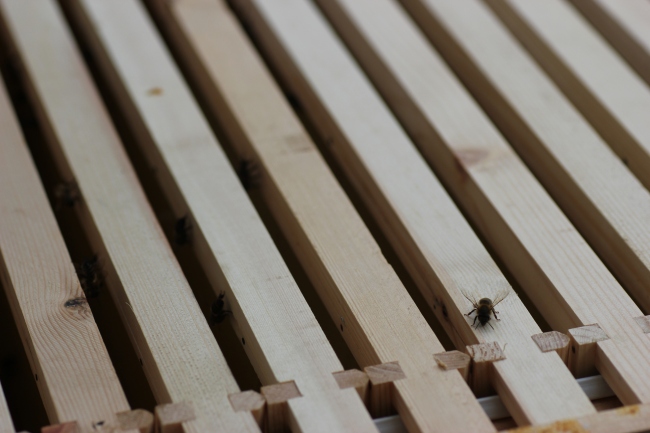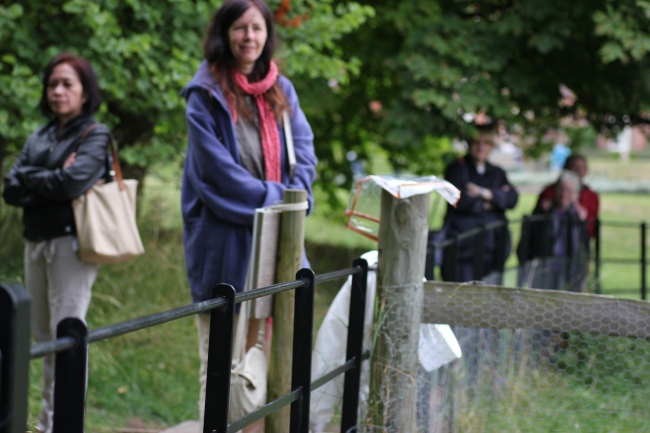We have a planning meeting once a month and that means our inspection time ends up being about 4 pm on a Tuesday instead of the more normal 2.30 pm. This inconsistency can be awkward for visitors so we decided that in future we would inspect before we have the meeting.
At our inspection today we were putting on clearing boards. When we are ready to harvest honey, we need to get the bees out of the upper, shallower boxes that contain just honey as opposed to the deeper boxes that are the ‘nursery’ containing eggs and larvae as well as honey and pollen. The brood box is separated from the supers with a Queen Excluder inserted between. A mated queen is simply too fat to get through the holes so she cannot lay eggs in the higher supers.
It is always difficult to convey to visitors the experience of opening a hive without exposing them to the risk of stings.
Once the roof and the crown board are removed we can see the frames in the top box. Sometimes the bees have hardly started to work it and it looks as though there are few bees:
At other times, the bees are so busy they almost look like a mass of black oil bubbling up as we let light into the usual darkness of their labour. The latter can be daunting for new beekeepers. If the bees are unhappy, due to weather conditions or because they have spent days protecting their stores from marauding wasps, the air can quickly be a swirling mass of bees and wise beekeepers are glad they have double checked there are no holes in their beesuit or veil.
The bees like to stick together parts of the hives to reduce gaps and draughts. Beekeepers need to look at each frame to see whether there it has stores, pollen, eggs and larvae. Often we need to ‘crack’ open the glued together frames. If you hear the sound you’ll now the word is appropriate. Often we will start at one end and find a frame full of stores which means we can leave the frame out making it easier to move the other frames. Frames with eggs and larvae need to be kept constantly warm and if they are left out for long we run the risk of killing the larvae. Sometimes we are lucky enough to see the queen. At times we see queen cups – possibly a sign that the colony is thinking about swarming. If we break down queen cups we can reduce the chance we will lose half our colony in a swarm. However, if there is no queen for some reason we need to leave such a queen cell.
We may see other things of interest – we might see coloured pollen sacs which indicate what plants are being foraged. We may see a waggle dance where one worker shares her find of a new source of pollen or nectar. Sometimes we see a new bee just climbing out of its cell for the first time or one bee feeding another.  Sometimes it seems that the bees are posing for us but more often than not they scurry away from the light. We make a note of what we find and then close up the hive again.
Sometimes it seems that the bees are posing for us but more often than not they scurry away from the light. We make a note of what we find and then close up the hive again.
Often the best views for the visitors are seeing the bees foraging in the parterre or the walled garden or collecting water.
The above picture shows a honey bee working a hydrangea; you can just see the pollen collected in the sacs on its back legs – a sort of beige/pale mustard colour.
The wasps can be seen more from mid August. This picture shows a wasp in the foreground and a honey bee further back. Many people claim not to be sure of the difference but hopefully the yellower sections of colour and narrower body of the wasp can be seen here. It also shows why the phrase ‘wasp waist’ arose.
In the hottest days of Summer the bees on this Cotswold stone colour bird bath looked as though they were sunbathing holidaymakers at a beach.
Back to the beginning – I said we were clearing the supers ready to extract. A clearer board is basically a crown board with oval holes into which porter bee escapes can be placed. they act like a valve; the bees can go down into the brood box below but they cannot get back up into the super so after a couple of days the super is hopefully clear of bees enabling us to remove the top box without being bothered too much by bees.
it is usually Olwyn who bakes us delicious cakes for our meetings. Today’s meeting had two bonus delicacies. Adam decided to showcase his cake making abilities and I made some chocolate bees. There were none left for the day’s visitors!









Love the chocolate bees, so sweet. Nice descriptions of the sights and sounds of beekeeping too.